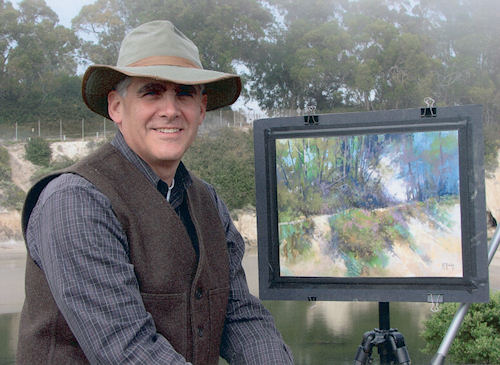This is part 3 of the 2011 IAPS recap by our treasurer, Anne Kiefaber. Read Part 1: The Setting and Part 2: Workshops and Demonstrations
The Franciscan was one of the larger of the hotel’s meeting rooms and it was packed when Richard McKinley walked in the room. A tall, slim, rather good-looking man, who reminded me of George Clooney once he started speaking. His delivery was funny, personable and clever.
One of the more interesting of the demos, Richard McKinley’s approach was entertaining and well-planned. In his approach, he uses watercolor as an under painting, and in today’s demo it was a scene in Oregon showing an interesting line of tall pine trees along the horizon with a stream and ditch coming forward in the picture plane. His process has three parts to it: Sensitivity, the concept and the drawing stage; Serendipity, the intuitive rendering of your under-painting; and Solution, finishing the painting.
During the Sensitivity stage, Richard draws in his subject, using pencil. He places a dot in the center of his paper so he is aware where the center lies. The he draws in his subject, keeping it very loose, though he is very conscious of the perspective of the land and the trees, indicating this with concentric lines for trees going upward and simultaneously curved lines that follow hollows of the land. Richard uses a very sketchy style in his drawing because as he says, “There are no lines in nature. We are the ones that finish the closures.” Also in this stage, he figures out where his area of interest will be. During this conceptual stage, he decides on the horizon level, so he is mentally placing himself in the scene. Where one places the horizon says something about your feelings. If one is looking down, the feeling of the piece will be introspective whereas above the line is more ethereal. You, the artist, are in control of the placement. He relies on the rule of thirds: field of vision, field of view and depth and breadth.
The Serendipity or under-painting stage is the set up of your idea. This is where you set up the majority of your values and edges, soft to sharp and dark to light. “Be Playful,” he advises. In his watercolor under painting, he used: warm yellow, alizarin crimson, ultramarine blue, sap green and burnt sienna to make all his mixtures. Richard puts his darks in first and says that when in doubt use Payne’s grey or a neutral. He was working wet in wet on sanded paper and was allowing the all the drips to remain. He used warmer tones in the foreground and bluer ones in the background, using a “sfumato” technique where the transition between the lights and darks was smoky. He likes his under painting to be perceived as through a veil once he has applied his pastel. He feels this gives a feeling of depth in the landscape, so one has the subtle perception of things underneath. Richard uses complimentary colors in areas of luminosity like sky or water to create that quality of light that is opalescent. He uses orange and alizarin crimson in the sky and adds blue across part of it. He also adds green near the horizon but also uses this cool somewhere else in the painting.
Richard McKinley adds most of his pastel in the Solution part of his painting process. He advises that dark is a weight and suggests adding the darks and lights at the same time into the area of interest. Develop them simultaneously, and never get your dark darker than value three. He tries to use values that are close to the under painting, and advises trying to repeat the color whenever possible and weave other colors through it. When he uses his softer pastels, he uses it like staccato in music with pings of accents like dots or dashes.
Richard McKinley relies on field sketches, rather than photography, to understand the way the light and dark on the land works and also to finish his pieces in the studio. When out in the field, he has another bunch of 3’s he considers: where to paint, where to pee and where to park. His audience roared when he told us that one, as it is so true when one is working in plein-air.
A wonderful demo, full of interest, hilarity and earnestness as one feels he cares very much about his art and about imparting helpful information to other artists.
